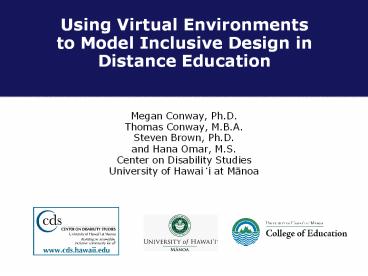Using Virtual Environments to Model Inclusive Design in Distance Education - PowerPoint PPT Presentation
Title:
Using Virtual Environments to Model Inclusive Design in Distance Education
Description:
Using Virtual Environments to Model Inclusive Design in Distance Education Megan Conway, Ph.D. Thomas Conway, M.B.A. Steven Brown, Ph.D. and Hana Omar, M.S. – PowerPoint PPT presentation
Number of Views:324
Avg rating:3.0/5.0
Title: Using Virtual Environments to Model Inclusive Design in Distance Education
1
Using Virtual Environmentsto Model Inclusive
Design in Distance Education
- Megan Conway, Ph.D.Thomas Conway, M.B.A.Steven
Brown, Ph.D. - and Hana Omar, M.S.
- Center on Disability Studies
- University of Hawaii at Manoa
2
Importance of Universally Designed Distance
Education
- Technologies used to deliver distance education
are constantly changing. - Innovations include web conferencing, social
networking, and multi-user environments that take
advantage of the internet and multimedia tools. - Section 508 of the Vocational Rehabilitation Act
to emphasize information technology accessibility
for individuals with disabilities.
3
Benefits and Challenges of Distance Education
- According to the U.S. Department of Education, in
2006-2007, 65 of postsecondary institutions
offered distance education credited courses and
23 offered non-credit distance education
courses. - The estimate for the total number of students
registered in online and blended courses was 12
million (U.S. Department of Education, 2008)
4
Universal Design for Learning (UDL)and Distance
Education
- UDL is based on the architectural concept of
Universal Design that means the environment is
usable by everyone (Roberts, Park, Brown,
Cook, 2011). - Assistive Technology Act of 1998, UDL is defined
as A scientifically valid framework for
guiding educational practice that - (A) provides flexibility in the ways information
is presented, in the ways students respond or
demonstrate knowledge and skills, and in the ways
students are engaged and - (B) reduces barriers in instruction, provides
appropriate accommodations, supports, and
challenges, and maintains high achievement
expectations for all students, including students
with disabilities and students who are limited
English proficient (quoted in Edyburn, 2010).
5
Description of Accessibility and Distance
Education Second Life Instructional Unit
- Accessibility and Distance Education is a 3-D
world educational unit created in Second Life
(SL) to educate postsecondary stakeholders about
accessibility issues and solutions in distance
education. The unit is housed on the University
of Hawaii, College of Educations Virtual Island
in SL. - Through its use of multiple means of
representation, expression and engagement,
Accessibility and Distance Education also
demonstrates how Universal Design principles can
be applied in a distance education context. SL
allows users to participate in a number of
simulations that give them hands-on experience
with accessibility issues and tools.
6
Builders of Accessibility SIM Davilla
Riddle Pulelehua RuthMarie Quirk Thomas
Conway ETEC 648D Fall 2010 Professor Peter Leong
7
Description of Accessibility and Distance
Education Second Life Instructional Unit
- Phase One definitions and issues of
accessibility for online education
8
Description of Accessibility and Distance
Education Second Life Instructional Unit
- Phase Two media tools for online learning
9
Description of Accessibility and Distance
Education Second Life Instructional Unit
- Phase Three digital tools for multi-user virtual
environments (MUVE).
10
Implications for Future Innovation
- Preparing for New Technology
- A majority of the students who are currently
pursuing their postsecondary degrees have come of
age in a time of rapidly developing and changing
technology. As discussed in this paper, distance
education is rapidly gaining ground as a viable
means of mainstream instruction. Instructors need
to understand multi-media of all kinds, including
MUVE, in order to engage present students and to
prepare to engage them in the future. - Engaging Faculty and Students in Innovative Ways
- When considering inclusive design we must
recognize the growing application of Virtual
Environments to provide real life experiences
and tools. These educational materials must be
presented in a format that is as cutting edge as
the new technology that instructors are being
asked to apply in the classroom.
11
Summary
- The innovative professional development module
created in Second Life, Accessibility and
Distance Education, described in this paper is
intended to exemplify how inclusive design in
higher education includes careful attention to
distance education and related new technology
such as Second Life (SL). We provided an overview
of Universal Design for Learning in Distance
Education, stressing the need for innovative
curriculum such as Accessibility and Distance
Education, and giving examples of techniques for
utilizing SL as an educational tool that is
inclusive of all learners. We conclude that the
field of disability and higher education must pay
keen attention to new developments in technology
so that students with disabilities will be full
participants in modern education.
12
Questions?
- Thomas Conway
- tconway_at_hawaii.edu
- www.cds.hawaii.edu































